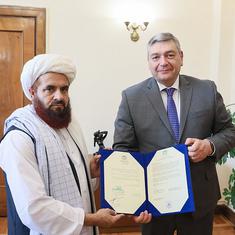The mythological film, India’s founding film genre, presented ideas of the past which were read as history by many people who view the Mahabharata as ushering in the current aeon (yuga) and who believe that Rama ruled Ayodhya 5,000 years ago. By the late 1940s, the mythological film had moved into a b-genre and fewer of them were being made, although there was the occasional success of one of these in the mainstream, notably the huge hit Jai Santoshi Maa (Hail Santoshi Maa, dir. Vijay Sharma, 1975). However, it was the two television series mentioned above which conflated history and mythology in new ways and reached such enormous audiences. Films throughout the century have also reconsidered history via their historical genre. Film is one of the most powerful media from which to learn history and is often the only way that people know about history at all.
Hindi cinema interprets Indian history, telling stories about the nation whether under threat or victorious, looking at sexuality and gender, looking at great figures of the past, implying a contrast with the present, and considering other such themes – rather than trying to represent accurately the given historical moment. The past is used, then, as a heterotopia, or another place, more often than as a heterochronia, or different time. The past shown in the film can then tell us more about the present than the present itself can.
These are not the official views of history, based on facts and archives or research monographs written by professional historians. Indian cinema’s history belongs instead to another kind of history – a popular view of the past, sometimes called ‘bazaar history’, whose stories and images derive from epics, poems, theatre, and folktales. This kind of history is closely linked to the urban theatre that emerged in the nineteenth century, the Parsi theatre, and to the mass-produced image enabled by calendar art (chromolithography) and photography.
The power of cinema’s history is that it often replaces academic history in the public imagination. Indian cinema’s history is not about truth nor is it an enquiry into truth. It is a presentation of the past built on images, words and the imagination. It is interested in rumour and gossip, to which facts are subsidiary. History must be told as plots, not events. Cinema is created imaginatively, using image, music and dialogue as the foundations upon which its own poetry and metaphor are developed and elaborated with gesture and costume to create a sensibility. History has to be shown in ways that suit the features of the films and their genres.
The form of the Hindi film, with its attractions of spectacle and star power, lends itself well to the demands of the historical genre. Indian cinema audiences like familiar stories and historical stories allow for ritualization, repetition and overvaluation of the past. These historical narratives suit the melodramatic mode of the Hindi cinema as they focus on crises and conflicts over power, legitimacy and identity through encounters with sickness and medicine, morality and the law and ethics and religion in a way that stirs up emotions. The films focus on topics that are common to historical narratives of struggle, sacrifice and patriotism. The historical film is particularly skilled at depicting the nation in crisis, so the films are about the melodrama of the nation itself, not just its heroes and heroines who are struggling and often sacrificing their lives in its cause.
Hindi films are often ‘star vehicles’, and so the historical film is often history as the story of individuals and families, where a well-known historical figure is played by a major star. The star embodies national sexual and gendered values, thus the historical film allows societal and economic values from the present to be transferred to the past as those associated with the star are ascribed to the historical figure and vice versa. The star is a melodramatic figure known beyond their films and brings to film his or her other characters, as well as lending iconicity to the historical character while being part of history her/himself.
Cinema itself is also part of India’s history, and it does not just reflect official or academic history but supplements it. The Hindi film, with its enormous audiences, is closely connected to other forms of culture such as theatre, literature and television, which helps to create a commonsensical, consensual view of history. The historicals are not the products of directors who are historians manqués but rather the products of commercial film-makers aiming to reach the widest audiences using the form of the film. Although some film-makers do carry out historical research, it is the film form and its requirements which dominate.
Excerpted with permission from Picture Abhi Baaki: Bollywood as a Guide to Modern India (Hachette India/Paperback/ Rs 499) by Rachel Dwyer.











